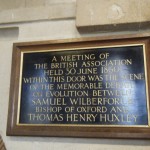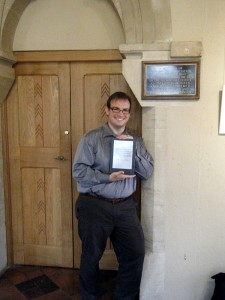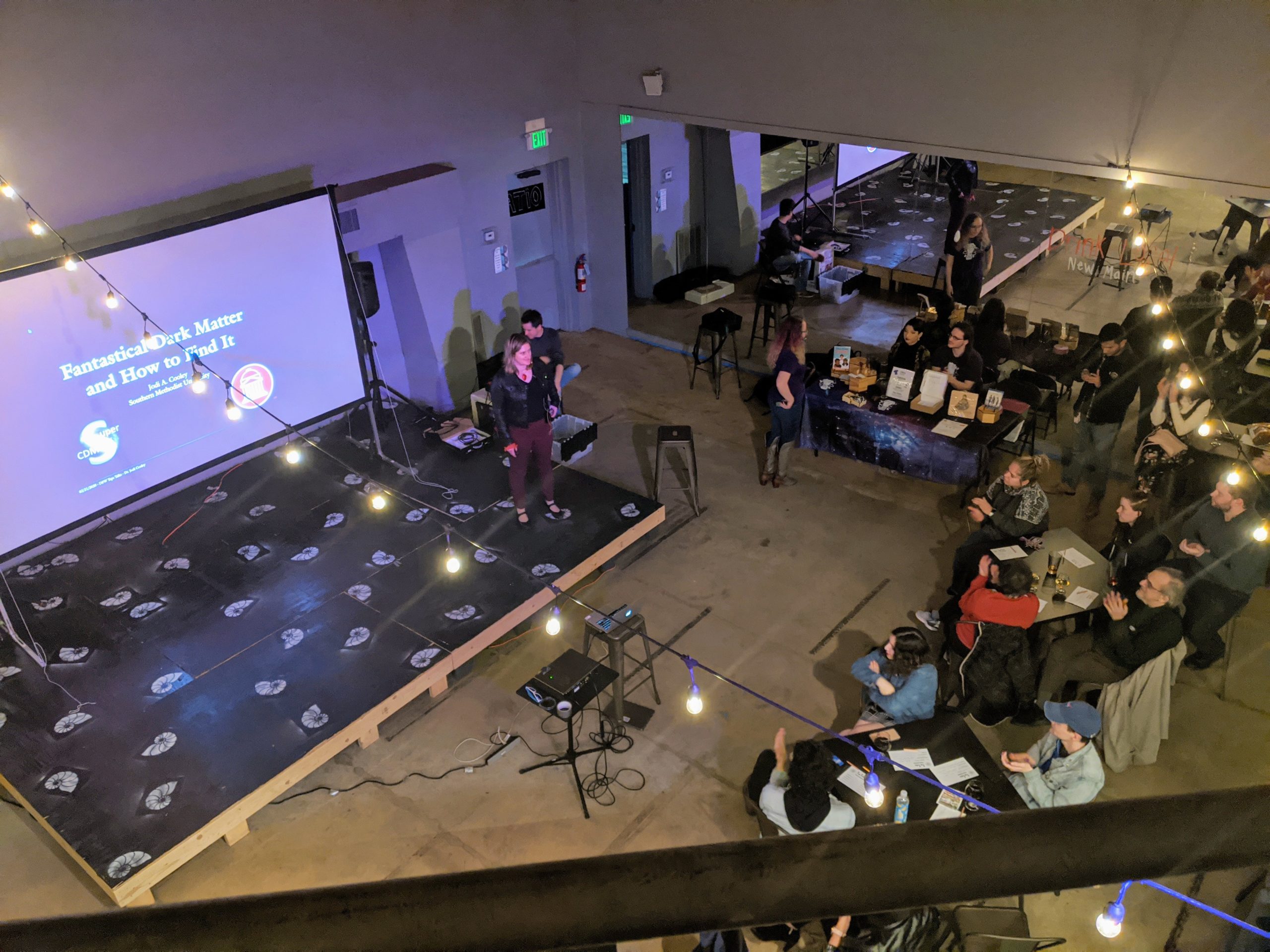So the story goes, at least as Carl Zimmer recounts it, during a debate between Thomas Huxley (a staunch defender of Charles Darwin’s then new Theory of Evolution by means of Natural Selection) and Bishop of Oxford Samuel Wilberforce (a staunch opponent of the theory) in the Natural History Museum of Oxford University, Wilberforce asked Huxley whether it was on his mother’s or on his father’s side that he was descended from an ape? To this came Huxley’s apocryphal reply,
“If then . . . the question is put to me would I rather have a miserable ape for a grandfather or a man highly endowed by nature and possessed of great means and influence and yet who employs these faculties and that influence for the mere purpose of introducing ridicule into a grave scientific discussion I unhesitatingly affirm my preference for the ape.” [Thomas Huxley, 1860, [1] ]
It is, for me, true or not, one of the most famous quotes any defender of the scientific method has ever put to a denier of the conclusions of that method. When I first heard it, it was being read aloud on an audiobook of Carl Zimmer’s “Evolution: The Triumph of an Idea” and sent chills down my spine. Since then, I have never ceased to feel a rush of excitement in both the wit and brevity of this comment. Whether uttered so clearly at the time or not, that is not the point; the point is how much it conveys the conviction of the scientist against the ridicule of the blind skeptic.
Today I visited the Oxford University Museum of Natural History. I missed going there on Monday night, when the workshop I am currently attending (ATLAS Upgrade Workshop) had a reception there. I was far too jet lagged at the time, but today I was able to step away from the workshop and take a quick tour of the Museum. My post-doc, Aidan, happened to be in England over the weekend and remained here with friends this week to be my guide (and also get some work done with me while we’re in the same physical location!). He insisted that I had to see the Museum, and whether or not he realized it he further enticed me by mentioning that the room where the aforementioned debate as held was housed in the building.
This was also timely because there has been an individual in Texas who has been spamming University faculty with emails railing against Evolution and touting Texas HB79 [2], the bill that would violate Federal law and allow for the posting of the Biblical ten commandments in school classrooms (why must people mix religion and science at the strangest of angles?). In one recent exchange with a professor from a Texas university, the spammer offered as an argument that humans cannot have evolved from apes,
Isn’t it amazing that fragile fish and bird-like ones have been preserved in stone in such quantities for the ages? Shouldn’t larger more dense primate bones be as abundant in the fossil record as well? In fact, they are…We have 1,000’s of fossils from a variety of animals; therefore, shouldn’t the species transitioning from monkey to human with their large bones be amply represented in the fossil record?
The answer to this rhetorical question would be yes, IF humans evolved from monkeys. BUT the fossil record does not support the theory that humans evolved from apes? [sic]
The response displays several classic misunderstandings of what the theory of evolutions tells us about apes and humans, as well as a misunderstanding both of the fossil record and of genetics. In fact, genetics – one of the most powerful tools we have for understanding how and when species shared a common ancestor – isn’t even mentioned in this argument.

The Museum of Natural History in Oxford puts that fossil record on display, from apes of various shapes and sizes, to proto-humans, to the modern Homo Sapiens. Varieties of more and more ape-like human species, going back thousands of years, have been found. Evolution doesn’t say that there was an orderly and smooth progression from one to another; rather, it says that we have common ancestors and branched off from those. Neanderthals, of which there is abundant fossil evidence, disappeared from the face of the earth around the time that Cro-Magnon was also running around. Human species reaching back in time to the heart of Africa – Homo Habilis – have been found [3]. Prior to them was Australopithecus, a transitional form between chimpanzee and some of the original human species. Homo and Australopithecus diverged about 2.5 million years ago; chimpanzees and Ardipithecus, the ancestor of Australopithecus, diverged about 5 million years ago. It’s the greatest fossil of all – our molecular DNA composition – that teaches us about when chimpanzees (our closest relative) and humans diverged from a common ancestor. As for classical fossils – well, the earth is a big place and we’ve barely scratched its surface. There is so much waiting for us to discover out there.
And if encyclopedic articles are not your taste, witness the display of fossils in the Museum of Natural History. In a single, long display, they capture snapshots of what we have learned about apes and their variety, and humans and their variety.
Aidan noted something rather profound about this Museum. In stark contrast to American equivalents, Evolution isn’t cautiously presented to you in a way that doesn’t offend your faith. Here, Evolution is revealed in its fullest glory – plant evolution, animal evolution, human evolution. Body plans of insects – thousands of them – are on display. Bird and fish species, human ancestors, dinosaurs, and all manner of other things are displayed in stunning numbers. To further reveal the humility that we, as a species, should feel, we are reminded how small and fragile our own planet is. A model of the sun sits at one end of the museum, and a model of the earth and moon at the other. They are scaled in size to the proportion of their distance in the museum to the actual distance of the Earth and Sun. From the tiny Earth and Moon, you can look across and see the Sun. From the Sun, you look across and don’t even notice the Earth – it’s too tiny to be seen with the eye. It’s stunning.

Near the end of our walk around the top of the museum, we can to the door that leads to the room where Huxley and Wilberforce debated Evolution in front of an audience. I asked Aidan to take a photo of me standing next to the door and the plaque near the door. I drew from my backpack by Amazon Kindle DX, quickly searched the index of books, and brought up “On the Origin of Species” by Charles Darwin. Here, almost 151 years from the date of this famous debate, I can stand proudly as a scientist, holding one of my many copies of this seminal work, and draw strength from the bravery of scientists like Charles Darwin. He worked for nearly 20 years to understand his observations of the natural world, eventually only publishing because a young scientist named Alfred Wallace uncovered many of the same conclusions from his own voyages and observations. He did not know the method by which descent with modification worked, but Evolution required the existence of genetics and its foundation – DNA – and the discovery of those things over the next 150 years helped to place a missing piece of the Evolutionary puzzle.

I felt only wonder and joy in my exploration of the Museum of Natural History in Oxford. Aidan told me that the modern champion of Evolution, Richard Dawkins, considers this edifice his own kind of cathedral. For all the excitement and lightness of being I felt while exploring the natural wonders inside this building, I can see how that might be true.
[1] http://en.wikipedia.org/wiki/1860_Oxford_evolution_debate
[2] http://www.legis.state.tx.us/BillLookup/History.aspx?LegSess=82R&Bill=HB79



